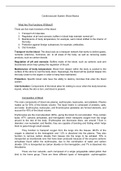Cardiovascular System: Blood Basics
What Are The Functions Of Blood?
There are five main functions of the blood:
1. Transport of molecules
2. Regulation of pH and osmosis; buffers in blood help maintain normal pH.
3. Maintenance of body temperature; for example, warm blood shifted to the interior of
the body.
4. Protection against foreign substances; for example, antibodies.
5. Clot formation.
Transport via the blood: The blood acts as a transport network that works to deliver gases,
nutrients (vitamins), hormones, etc. to all areas of the body; as well as removing waste
products, such as carbon dioxide.
Regulation of pH and osmosis: Buffers inside of the blood, such as carbonic acid and
bicarbonate anion help upkeep the regulation of the pH.
Maintenance of body temperature: Blood from deeper within the body is pushed to the
surface of the skins to cool the body down. Opposingly, the blood will be pushed deeper into
the body closer to the organs in order to keep heat maintained.
Protection: Specific blood cells have the ability to destroy microbes that enter the blood
system.
Clot formation: Components of the blood allow for clotting to occur when the body becomes
injured, where the skin is torn, and blood is present.
Composition of Blood
The main components of blood are plasma, erythrocytes, leukocytes, and platelets. Plasma
makes up for 55% of the bloods volume; The liquid matrix is composed of proteins, salts,
and water. Erythrocytes, leukocytes, and thrombocytes (platelets) are formed elements, and
account for 45% of the blood volume.
Erythrocytes are the most abundant (95%), giving the blood it’s red coloration. They contain
lipids, ATP, carbonic anhydrase, and hemoglobin which transports oxygen from the lungs
around to the rest of the body. Erythrocytes are biconcave discs, are around 7.5um in
diameter, non-nucleated, and flexible, they are capable of bending and folding which helps
them to pass through small vessels.
They function to transport oxygen from the lungs into the tissues, 98.5% of the
oxygen is attached to the hemoglobin and 1.5% is dissolved into the plasma. They also
function to remove carbon dioxide from tissues into the lungs to be exhaled, 70% is
transported as bicarbonate ions that have been produced because of the enzyme carbonic
anhydrase found within the erythrocytes, due to the combination of water and carbon
dioxide. 23% is transported as carbon dioxide on the hemoglobin, and 7% is dissolved into
the plasma.
There are four subunits, each composed of a single polypeptide called globin that
bind to the heme group. There are three different types of hemoglobin: oxyhemoglobin




